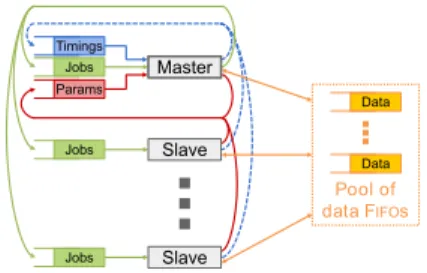HAL Id: hal-01075114
https://hal.archives-ouvertes.fr/hal-01075114
Submitted on 16 Oct 2014
HAL is a multi-disciplinary open access
archive for the deposit and dissemination of
sci-entific research documents, whether they are
pub-lished or not. The documents may come from
teaching and research institutions in France or
abroad, or from public or private research centers.
L’archive ouverte pluridisciplinaire HAL, est
destinée au dépôt et à la diffusion de documents
scientifiques de niveau recherche, publiés ou non,
émanant des établissements d’enseignement et de
recherche français ou étrangers, des laboratoires
publics ou privés.
PiSDF: Parameterized & Interfaced Synchronous
Dataflow for MPSoCs Runtime Reconfiguration
Karol Desnos, Julien Heulot
To cite this version:
Karol Desnos, Julien Heulot. PiSDF: Parameterized & Interfaced Synchronous Dataflow for
MP-SoCs Runtime Reconfiguration. 1st Workshop on MEthods and TOols for Dataflow PrOgramming
(METODO), ECSI, Oct 2014, Madrid, Spain. �hal-01075114�
PiSDF: Parameterized & Interfaced Synchronous
Dataflow for MPSoCs Runtime Reconfiguration
Karol Desnos
IETR, INSA Rennes, UMR CNRS 6164, UEB 20 avenue des Buttes de Co¨esmes
35708 Rennes, France Email: kdesnos@insa-rennes.fr
Julien Heulot
IETR, INSA Rennes, UMR CNRS 6164, UEB 20 avenue des Buttes de Co¨esmes
35708 Rennes, France Email: jheulot@insa-rennes.fr
Abstract—Dataflow models of computation are widely used for the specification, analysis, and optimization of Digital Signal Processing (DSP) applications. In this talk, we present the Parameterized and Interfaced Synchronous Dataflow (
π
SDF) model that addresses the important challenge of managing dynamics in DSP-oriented representations. In addition to cap-turing application parallelism, which is an intrinsic feature of dataflow models,π
SDF enables the specification of hierarchical and reconfigurable applications. The Synchronous Parameterized and Interfaced Dataflow Embedded Runtime (SPIDER) is also presented to support the execution ofπ
SDF specifications on heterogeneous Multiprocessor Systems-on-Chips (MPSoCs).I. PARAMETERIZED ANDINTERFACEDSYNCHRONOUS DATAFLOW(
π
SDF)A dataflow Model of Computation (MoC) models an appli-cation as a directed graph of computational entities, called ac-tors, that exchange data packets, called data tokens, through a network of First-In First-Out queues (FIFOs) [1]. Synchronous Dataflow (SDF) [1] is the most commonly used dataflow MoC. Production and consumption token rates are fixed scalars in an SDF graph. A static analysis of an SDF graph ensures consistency and schedulability properties that imply deadlock-free execution and bounded FIFOmemory needs.
SetN
Filter
Kernel
Send Read size size3
size size size/N size/N size/N size/N size size 1 N size x2*size size size
Fig. 1. Example of
π
SDF graph.The
π
SDF MoC [2] is a generalization of the SDF MoC. In addition to the actors and FIFOs of the SDF semantics, theπ
SDF semantics contains a set of parameters and parameter dependencies that can be used to reconfigure the production and consumption token rates of actors. Theπ
SDF semantics also includes a hierarchy mechanism that enables the compo-sition of graphs by using aπ
SDF sub-graph as a specification of the internal behavior of an actor.A
π
SDF specification of an image processing is presented in Figure 1. The top-level graph of this application contains three actors. The Filter actor is a hierarchical actor whose internal behavior is specified with a sub-graph. Parameters size and N influence the behavior of the application at compile time and at runtime respectively.II. SYNCHRONOUSPARAMETERIZED ANDINTERFACED DATAFLOWEMBEDDEDRUNTIME(SPIDER) The SPIDER runtime [3] is a Real-Time Operating Sys-tem (RTOS) whose purpose is to map and schedule
π
SDF graphs on heterogeneous Multiprocessor Systems-on-Chips (MPSoCs). The SPIDER runtime exploits the parallelism and the predictability ofπ
SDF specifications to minimize the latency of applications. Jobs Jobs Jobs Params Timings Data Data Pool of data FIFOs Slave Slave MasterFig. 2. Operating principle of the SPIDERruntime.
Figure 2 illustrates the operating principle of the SPIDER runtime. The purpose of the Master core is to make mapping and scheduling choices and send jobs to all processing ele-ments, including itself, through FIFOs. On job completion, a core can send new parameter values and monitoring informa-tion back to the master core through the Params and Timings FIFOs respectively. A pool of data FIFOs can be accessed by Master and Slave cores to exchange data between jobs.
REFERENCES
[1] E. Lee and D. Messerschmitt, “Synchronous data flow,” Proceedings of the IEEE, vol. 75, no. 9, pp. 1235 – 1245, sept. 1987.
[2] K. Desnos, M. Pelcat, J.-F. Nezan, S. Bhattacharyya, and S. Aridhi, “PiMM: Parameterized and Interfaced Dataflow Meta-Model for MPSoCs Runtime Reconfiguration,” in SAMOS XIII. IEEE, 2013.
[3] J. Heulot, M. Pelcat, K. Desnos, J. F. Nezan, and S. Aridhi, “SPIDER: A Synchronous Parameterized and Interfaced Dataflow-Based RTOS for Multicore DSPs,” in EDERC14, 2014.
